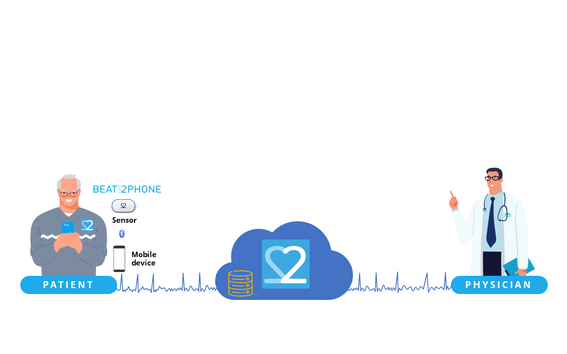ECG long-term monitoring helps to prevent strokes, save lives, and reduce healthcare costs. - Henna Pirskanen, An Chen, Risto Soila & Satu Kaleva

“Using Beat2Phone monitoring solution could lead to six fewer strokes and save around 100 000 € in one year”
Long-term monitoring is fundamental in prevention of cardiovascular diseases & complications
Cardiovascular diseases form a global risk on mortality and impose economic burden on the healthcare system1. In Europe, 1% to 2% of the population experiences atrial fibrillation (AF), the most common cardiac arrhythmia that can lead to stroke and heart failure2. The estimated number of people with AF is 17.9 million by the year 20603-6. The number is getting higher as the proportion of patients found with stroke and AF increases when more long-term electrocardiogram (ECG) monitoring is performed6-9.
Holter ECG has long been the standard method for monitoring patients with ischemic stroke or TIA10. Holter usually lasts for 24 to 48h and is cumbersome to initiate and uncomfortable for the patient to wear due to long lead wires and movement restrictions11. As episodes are often sporadic, without long term continuous monitoring it is challenging to detect and record occurrences of heart problems in real-time, e.g. AF, in a “real world” setting.
Beat2Phone enables long-term remote self-monitoring
Heart problems get usually detected and diagnosed over hospitalization, which is associated with significant costs10. In addition, the conventional monitoring methods used in healthcare can detect only a fraction of asymptomatic and sporadic atrial fibrillation during the diagnostic work-up after an ischemic cerebrovascular event. Enabled by advanced technologies including wireless communication, powerful electronic processing and cloud applications, “simple” smartphone-based remote ECG monitoring opens a new opportunity to improve the detection and management of cardiovascular conditions. This offers possibilities for patient self-monitoring which is becoming an increasingly important part of the monitoring practices.
VitalSignum Oy provides Beat2Phone ECG service (B2P ECG), a wearable 1-lead ECG sensor with a phone application connected to a cloud service that stores and analyzes the ECG with an advanced algorithm and displays the results on a web dashboard. This type of remote self-monitoring could offer many advantages, including early, real-time and fast detection of illnesses, continuous monitoring of patients, and reduction in follow-up visits and hospitalizations13-15. However, prior to its wide use in real clinical practices, more empirical evidence about the real effect and impact is required.
Positive impacts from implementing mobile technology for screening atrial fibrillation after an ischemic event
As one part of the MASSE project and VitalSignum’s collaboration, a pilot of using VitalSignum’s B2P ECG service was conducted in the neurology ward of Helsinki University Hospital (HUS) in April-June 2021 to screen atrial fibrillation after an ischemic stroke or a transient ischemic attack. One part of the pilot on B2P ECG’s influence focused on the patient pathway, costs and the detection and outcomes of atrial fibrillation. Evidence collected from this part of the pilot shows that compared to the standard method Holter (lasting for 24h), B2P ECG provides longer monitoring periods (two weeks), increases probability of detecting AF, improves secondary preventive treatment, and makes clinical pathway more efficient. Specifically, in one year the longer ECG monitoring could lead to six fewer strokes.
The study also shows that the professionals saw the B2P self-monitoring solution as an acceptable method and viewed the solution as the trend for efficiently using hospital resources. It also helped professionals to understand patient recovery and health risks within a particular period of time. From professionals’ perspective, B2P ECG was also usable, providing more monitoring opportunities and better monitoring coverage, shortening patients’ waiting time, enhancing patient involvement, and reducing need for patient transfers. In addition, professionals informed that it was easy to get results and interpret the data with B2P service. The study estimates, using Beat2Phone could help HUS neurology ward save around 100 000 € in one year.
VitalSignum is conducting another pilot in HUS Lohja regional hospital involving the ward patients being monitored for a few days for AF. This will provide more insight on the B2P usability in the hospital environment from the professional use perspective.
Study results support further development B2P monitoring solution
Both pilots indicated that it is worth developing the solution further and making changes by integrating Beat2Phone into clinical pathway of caring and managing patients and using it as a supplementary monitoring solution for current existing solutions (e.g. Holter).
More details can be found:
Etämonitorointia ja huolenpitoa - Risto Soila
Improving heart monitoring after ischemic cerebrovascular events
References
1. Uddin AA, Morita PP, Tallevi K, et al. Development of a wearable cardiac monitoring system for behavioral neurocardiac training: a usability study. JMIR mHealth and uHealth 2016;4(2):e5288.
2. Hickey KT, Hauser NR, Valente LE, et al. A single-center randomized, controlled trial investigating the efficacy of a mHealth ECG technology intervention to improve the detection of atrial fibrillation: the iHEART study protocol. BMC Cardiovasc Disord 2016;16(1):1-8.
3. Chugh SS, Havmoeller R, Narayanan K, et al. Worldwide epidemiology of atrial fibrillation: a Global Burden of Disease 2010 Study. Circulation 2014;129(8):837-47.
4. Krijthe BP, Kunst A, Benjamin EJ, et al. Projections on the number of individuals with atrial fibrillation in the European Union, from 2000 to 2060. Eur Heart J 2013;34(35):2746-51.
5. Scowcroft A, Cowie M. Atrial fibrillation: improvement in identification and stroke preventive therapy—data from the UK Clinical Practice Research Datalink, 2000–2012. Int J Cardiol 2014;171(2):169-73.
6. Klijn CJ, Paciaroni M, Berge E, et al. Antithrombotic treatment for secondary prevention of stroke and other thromboembolic events in patients with stroke or transient ischemic attack and non-valvular atrial fibrillation: a European Stroke Organisation guideline. European stroke journal 2019;4(3):198-223.
7. Wachter R, Groeschel K, Gelbrich G, et al. Holter-electrocardiogram-monitoring in patients with acute ischaemic stroke (Find-AFRANDOMISED): an open-label randomised controlled trial. The Lancet Neurology 2017;16(4):282-90.
8. Gladstone DJ, Spring M, Dorian P, et al. Atrial fibrillation in patients with cryptogenic stroke. N Engl J Med 2014;370:2467-77.
9. Sanna T, Diener H-C, Passman RS, et al. Cryptogenic stroke and underlying atrial fibrillation. New England Journal of Medicine 2014;370(26):2478-86.
10. Caceres BA, Hickey KT, Bakken SB, et al. Mobile electrocardiogram monitoring and health-related quality of life in patients with atrial fibrillation: findings from the iPhone Helping Evaluate Atrial Fibrillation Rhythm Through Technology (iHEART) study. J Cardiovasc Nurs 2020;35(4):327-36.
11. Walker AL, Muhlestein JB. Smartphone electrocardiogram monitoring: current perspectives. Advanced Health Care Technologies 2018;4:15-24.
12. Hindricks G, Potpara T, Dagres N, et al. 2020 ESC Guidelines for the diagnosis and management of atrial fibrillation developed in collaboration with the European Association for Cardio-Thoracic Surgery (EACTS) The Task Force for the diagnosis and management of atrial fibrillation of the European Society of Cardiology (ESC) Developed with the special contribution of the European Heart Rhythm Association (EHRA) of the ESC. Eur Heart J 2021;42(5):373-498.
13. Malasinghe LP, Ramzan N, Dahal K. Remote patient monitoring: a comprehensive study. Journal of Ambient Intelligence and Humanized Computing 2019;10(1):57-76.
14. Pereira T, Oliveira T, Cabeleira M, et al. Comparison of low-cost and noninvasive optical sensors for cardiovascular monitoring. IEEE Sensors Journal 2012;13(5):1434-41.
15. Sticherling C, Kühne M, Schaer B, et al. Remote monitoring of cardiovascular implantable electronic devices. Swiss Med Wkly 2009;139:41-42.
Show other posts from this blog
MASSE-päätösseminaarissa julkaistiin hankkeen loppuraportti ja Virtuaalisen Hoidonohjaamon suunnitteluperiaatteet
Aalto-yliopiston vetämä MASSE-hanke on päättymässä ja reilun kaksivuotisen taipaleen tuloksista on julkaistu suomenkielinen loppuraportti.Virtual care operator is likely cost-effective in cardiovascular disease secondary prevention – Lalli Nurmi
Using a VCO in cardiovascular disease (CVD) secondary prevention would likely lead to improved health and economic outcomes in the society.